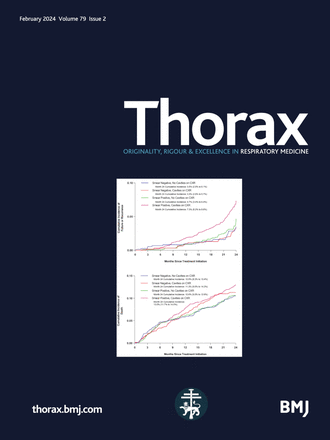Quantitative BAL: a suitable method for the assessment of epithelial lining fluid in alpha-1 antitrypsin deficiency?
IF 7.7
1区 医学
Q1 RESPIRATORY SYSTEM
引用次数: 0
Abstract
Measurements on biological fluids form the mainstay of routine clinical investigations. Samples of blood, urine, etc are, generally, easily obtainable and measurements can be interpreted directly. On the other hand, alveolar epithelial lining fluid (ELF) is relatively inaccessible but offers valuable insight into pathogenesis and pharmacokinetics relating to diseases affecting the alveolus. The lung is frequently described as having the surface area of a tennis court. When folded up to fit into the volume of an average thorax, it creates a complex maze that represents a significant obstacle to accessing ELF. The difficulty of gaining access safely and without disrupting the alveolar milieu is complicated by the delicate structure and function of the gas exchange membrane. Different approaches have been adopted including the use of a bronchoscopic microsample (PMS) probe,1 which allows direct measurements from ELF, or bronchoalveolar lavage (BAL), which requires a correction method to adjust for the dilutional effects of the lavage fluid. Urea (or albumin or creatinine) has been commonly used as an endogenous marker to estimate the volume of ELF2–5: by measuring the urea in BAL aspirate and plasma, a ratio can be calculated allowing an estimate of the dilution of apparent volume of ELF. ‘Contamination’ from lavage of the larger airways is also an issue that is influenced by the method of BAL sampling. This is not particularly important in routine clinical BAL, and guidelines do not stipulate the order of …定量 BAL:评估α-1 抗胰蛋白酶缺乏症上皮内衬液的合适方法?
生物液体的测量是常规临床检查的主要内容。一般来说,血液、尿液等样本很容易获得,测量结果也可以直接解释。另一方面,肺泡上皮内衬液(ELF)相对不易获得,但却能为了解与影响肺泡的疾病有关的发病机制和药代动力学提供宝贵的信息。肺经常被描述为网球场的表面积。当折叠起来与普通胸腔容积相适应时,它就形成了一个复杂的迷宫,成为进入 ELF 的重大障碍。由于气体交换膜的结构和功能十分微妙,要在不破坏肺泡环境的情况下安全进入肺泡十分困难。目前已采用不同的方法,包括使用支气管镜微型样本(PMS)探头1 或支气管肺泡灌洗液(BAL),前者可直接测量 ELF,后者则需要校正方法来调整灌洗液的稀释效应。尿素(或白蛋白或肌酐)通常被用作估算 ELF 容量的内源性标记物2-5:通过测量 BAL 吸出液和血浆中的尿素,可以计算出一个比率,从而估算出 ELF 表观容量的稀释程度。大气道灌洗造成的 "污染 "也是一个受 BAL 取样方法影响的问题。这在常规临床 BAL 中并不特别重要,指南也没有规定 BAL 采样的顺序。
本文章由计算机程序翻译,如有差异,请以英文原文为准。
求助全文
约1分钟内获得全文
求助全文
来源期刊

Thorax
医学-呼吸系统
CiteScore
16.10
自引率
2.00%
发文量
197
审稿时长
1 months
期刊介绍:
Thorax stands as one of the premier respiratory medicine journals globally, featuring clinical and experimental research articles spanning respiratory medicine, pediatrics, immunology, pharmacology, pathology, and surgery. The journal's mission is to publish noteworthy advancements in scientific understanding that are poised to influence clinical practice significantly. This encompasses articles delving into basic and translational mechanisms applicable to clinical material, covering areas such as cell and molecular biology, genetics, epidemiology, and immunology.
 求助内容:
求助内容: 应助结果提醒方式:
应助结果提醒方式:


